False practice 3
False practice 3
by
Jean Luc Cornille 2014
Dressage and In hand horse trainer
This does no means that Pluvinel was wrong; the Master was using the best technique available at this time. What is wrong is still applying the technique when advanced understanding of the equine physiology has demonstrated their ineffectiveness as well as damaging effects. Alvin Toffler magisterially summarized the problem. “The illiterate of the 21st century will not be those who cannot read and write, but those who cannot learn, unlearn, and relearn” 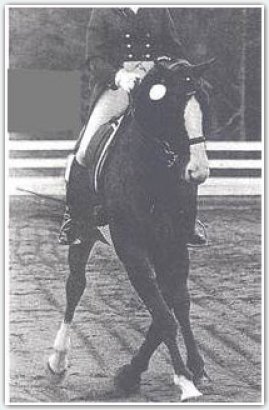
Albert Einstein said, “Education is not the learning of facts, but the training of the mind to think”. Therefore when advanced research studies expose the falsehood of previous facts, unlearning and relearning is not about erasing everything and restarting from scratch. Instead, relearning is about allowing a trained mind to think further.
Judging criteria do not discriminate performances executed by a horse adequately coordinated for the athletic demand of the movement, (what is correct,) from performances executed by a talented but dysfunctional horse, (false practice.) This picture of half pass for instance, was published with an article stating that the rider ended winning the test because of the quality of the half pass. The horse might fit the judging andards, (front limbs crossing above the knees,) but he is associating lateral bending with inverted rotation. The horse is talented but dysfunctional. Abnormal stresses created by inverted rotation affect not only the vertebral structure but also stifles, hock at the level of the hind legs as well as knees, fetlocks and hooves at the level of the forelegs. 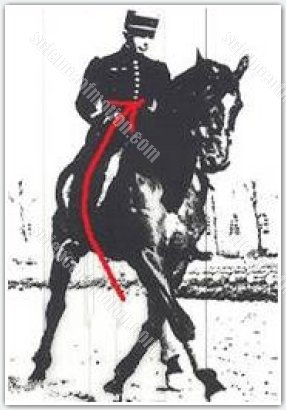
The next picture is from Colonel Margot executing the same half pass but with a functional athlete. Left lateral bending associated with the correct rotation. Margot’s performance was executed long before Jean Marie Denoix explained the phenomena of proper and inverted rotation. Margot was a genius. He had intuitively a deep sense of the body coordination appropriated for the movement. He was a difficult teacher because he could not stand watching a horse improperly coordinated for the athletic demand of the performance, but he did not have available at his time, the scientific knowledge that could explain his intuitions.
Margot expected the same intuition from is students and he often eased his frustration through sarcastic humor. One day, I was riding a horse in front of him and the horse passed a beautiful but unexpected flying change. Without a smile, he told me, “Make it look like you asked it. This is the best flying change that he will give you until you understand his physiology well enough to prepare him properly for the flying change.”
There are great advantages in knowing in details the body coordination preparing the horse physique for the athletic demand of each performance. Knowledge opens a totally new era in terms of equine athletic achievements and therapies. Dr Betsy Uhl DVM PhD commented, “The thought that the horse's gait can actually be changed to rehab or prevent injury is almost completely foreign to veterinarian and most trainers.” The norm always has been that dressage and other equine athletic activities cripple the horses and veterinarians and therapists are called upon to fix the damages. It turns out that the ability of correcting the kinematics abnormalities inducing lameness is essential. Treating lesions or muscles damages is necessary but without addressing and correcting the source of the kinematics abnormality causing the lesion, the full advantages of treatment regimen or therapies is never achieved. Back in motion, same aberrant limb kinematics or vertebral column dysfunction reoccurs inducing abnormal stresses and consequent injuries.
Dressage movements are either therapeutic or damaging. There is no neutral zone. Movements are damaging when the horse’s physiques is not adequately coordinated for the athletic demand. The horse executes the move protecting actual weaknesses, muscle imbalance, morphological flaw or other issue. Protective reflex contraction compromise limbs kinematics and thoracolumbar function downgrading performances below the horse’s potential and causing lameness. At the contrary, when the athletic demand of each dressage movement is soundly understood, not only the horse can be adequately developed and coordinated for the effort, but the movements can be applied targeting specific muscles group or body orchestration. By comparison to what can be done, limiting dressage movements to compulsories fitting the judging standards is wasting both, the horse and the rider’s intelligence.
Shoulder in for instance, is defined as a move where the horse body is laterally bend, forming an angle of 30° with the rail and traveling on three tracks. These standards downgrade Monsieur de la Gueriniere’s shoulder in at the level of a flat and useless compulsory. The shoulder for is massacred the same way. Gustave 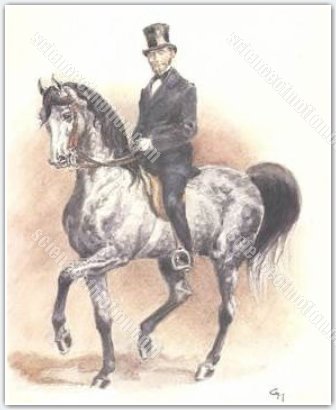 Steinbrecht regarded the shoulder for as a concept, not a movement. Steinbrecht created a body coordination associating lateral bending with proper transversal rotation. Proper correlation between lateral bending and transversal rotation predisposes effectively the horse physique for the athletic demand of the shoulder in. The fundamental point of Steinbrecht’s shoulder for is maintaining the haunches absolutely straight. Lateral bending of the thoracic spine is achieved precisely because the horse’s haunches remain straight on the rail. Promoting a distorted view of Steinbrecht’s concept, judging standards define the shoulder for as a small shoulder in where the horse’s body forms a light angle with the rail. This is false practice. This is typically the difference between a gymnastic exercise creating proper correlation between lateral bending and transversal rotation, which is the real shoulder for, and a pantomime imitating the move without understanding the coordination allowing the horse’s physique to fully benefit from Steinbrecht’s concept.
Steinbrecht regarded the shoulder for as a concept, not a movement. Steinbrecht created a body coordination associating lateral bending with proper transversal rotation. Proper correlation between lateral bending and transversal rotation predisposes effectively the horse physique for the athletic demand of the shoulder in. The fundamental point of Steinbrecht’s shoulder for is maintaining the haunches absolutely straight. Lateral bending of the thoracic spine is achieved precisely because the horse’s haunches remain straight on the rail. Promoting a distorted view of Steinbrecht’s concept, judging standards define the shoulder for as a small shoulder in where the horse’s body forms a light angle with the rail. This is false practice. This is typically the difference between a gymnastic exercise creating proper correlation between lateral bending and transversal rotation, which is the real shoulder for, and a pantomime imitating the move without understanding the coordination allowing the horse’s physique to fully benefit from Steinbrecht’s concept.
What is correct cannot be achieved through accessoires, neck posture and other simplistic approaches, What is correct is about guiding the horse’s brain toward the body coordination optimally adapted to the athletic demand of the performance. This is a classical art that has been fashioned through the wisdom of centuries, updated to actual understanding of the equine physiology and explained through the science of motion. On this picture. Chazot is on classical shoulder in. Chazot respects Monsieur de la Gueriniere thought not because he crosses the front legs above the knees, not because he is travelling on three tracks, not because his body form an angle of approximately 30° with the rail. The classicism of Chazot’s interpretation of the shoulder in has be hinted by François Robichon de la Gueriniere but not explained by the classic author for the very simple reason that the existence of transveral rotations was unknown at the 18th century. “The shoulder-in prepares a horse for placing his weight on his haunches because, with each step that he takes in this posture, he brings the inside hind leg forward under the belly and places it over the outside hind leg, which he cannot do without lowering the haunch.” In the French culture, what is said “between the lines” is almost as important as was is written on the lines. Lowering of the inside haunch demands lateral bending of the thoracic spine associated with proper rotation. 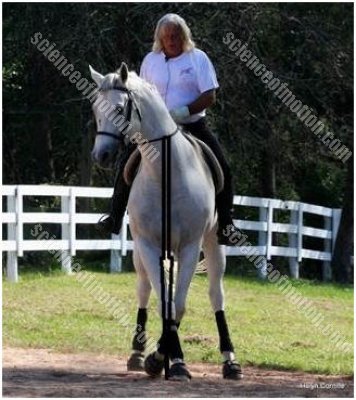
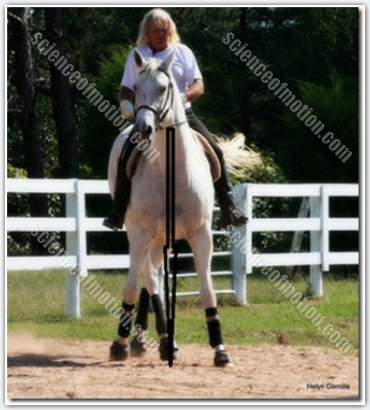
La Gueriniere did not have the available knowledge and scientific language to explain the existence of transversal rotations, but he sensed it between the lines. However, a horse can travels on three tracks with inverted rotation of the thoracolumbar spine. The horse fulfils then the judging standards but is physically dysfunctional and incapable of lowering the inside haunch and therefore benefits from the main purpose of the shoulder in.
The pictures illustrate the abduction, (left), and adduction, (right), phases of the shoulder in. Chazot’s whither remains perfectly vertical in relation to the ground. There is no shift over the right or left foreleg. This is the condition that renders the shoulder in efficient. This is what the IHTC is now explaining muscle by muscle and step by step.
Jean Luc Cornille
scienceofmotion.com


